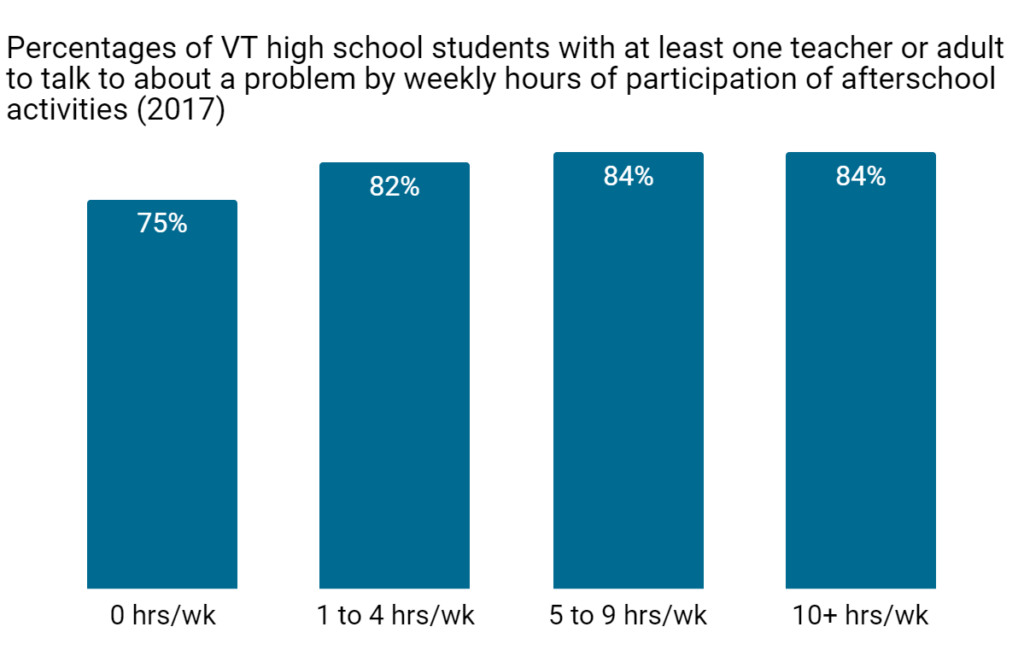For this month’s data digest, we look again at the results from the 2017 Youth Risk Behavior Study (YRBS), Every two years, the Vermont Department of Health administers the survey throughout the state in middle schools and high schools. In both 2015 and 2017, Vermont Afterschool submitted a question that was included on the high school survey. It asked students to indicate the number of weekly hours they participated in afterschool activities. In addition to responding to our question, over 20,000 high school students in the state responded to items related to their “risk” and “asset” behaviors and other demographic factors (see our past posts for our analyses of correlations between students’ afterschool participation in 2017 and bullying, screen time/physical activity, and academic performance; and for a post about LGBT students’ access to afterschool activities).
In 2017, the YRBS also included a few questions that helped reveal the extent to which students feel valued and connected in their communities. One question asked, “Do you agree or disagree that in your community you feel like you matter to people?” In total, 60.5% of high school students said that they either agreed (41.4%) or strongly agreed (19.1%) that they mattered to people in their community. This was an 11% increase from 2015.
We cross-tabulated the 2017 results with the students’ responses to our question about their extent of participation in afterschool activities. The data, visualized in the chart below are based on 20,009 students that responded to both items on the survey. We can see that as hours of participation in afterschool activities increased, the percentages of students who felt that they mattered in their communities also increased. For students that did not participate in afterschool programming, 47% agreed or strongly agreed that they mattered to people in their communities; for students who participated in between one and four weekly hours of programming, 63% agreed or strongly agreed that they mattered to people in their communities; for students who participated in between five and nine weekly hours of programming, 69% agreed or strongly agreed that they mattered to people in their communities; and for students that participated in ten or more hours per week of programming, 71% agreed or strongly agreed that they mattered to people in their communities.

Research by Jennifer Fredericks (2006) at Connecticut College backs up our findings; her research has shown that students who participate in extracurricular activities after school improve in their sense of belonging with their communities. Afterschool activities can give students opportunities to connect with their school and greater community in new and interesting ways. Whether they plant a community garden, showcase their talent in a theatrical performances, participate in community service, or learn some new skill that they can share, they are able to use their talents to connect with their communities in ways that they are not able to do during the regular school day or by just going home after school.
Afterschool activities that make students feel connected to their communities can serve another purpose. It can provide them with increased access to adults who might be able to help them solve problems. When students are in high school, they face a lot of pressure and challenges. They deal with peer pressure associated with risk behaviors like consuming drugs and alcohol. They also face academic pressures and need to make decisions about their futures. Not all students are able to talk about these issues with their family members; in fact some students might need to talk about issues within their families. When teens feel that they have an adult in their lives, whether a teacher or someone else with whom they can talk about their problems, they have a greater chance of success as they move forward in life. Afterschool participation and meaningful community connections help foster such connections.

The 2017 YRBS data helped back up these assumptions. There was an item on the survey that asked high school students, “Is there at least one teacher or adult in your school that you can talk to if you have a problem?” Eighty percent of students responded, “Yes” to this item. We looked at the responses to this item cross-tabulated with our question about hours of participation in afterschool activities. A total of 19,994 students responded to both questions. The chart below shows these results. In general, students who participated in afterschool activities were more likely to respond that they had an adult that they could talk to than students who did not participate in afterschool activities.
Afterschool programming is an important way for for high school students to feel that they matter in their communities and connect with adults who care about them. These are just a few more of many reasons to advocate for access to quality afterschool experiences.
Reference:
Fredricks, J. A., & Eccles, J. S. (2006). Is extracurricular participation associated with beneficial outcomes? Concurrent and longitudinal relations. Developmental psychology, 42(4), 698-713. Retrieved from http://citeseerx.ist.psu.edu/viewdoc/download?doi=10.1.1.546.5178&rep=rep1&type=pdf

